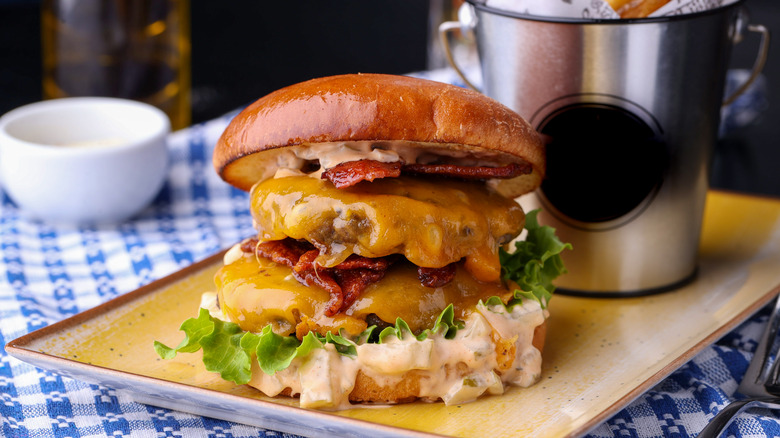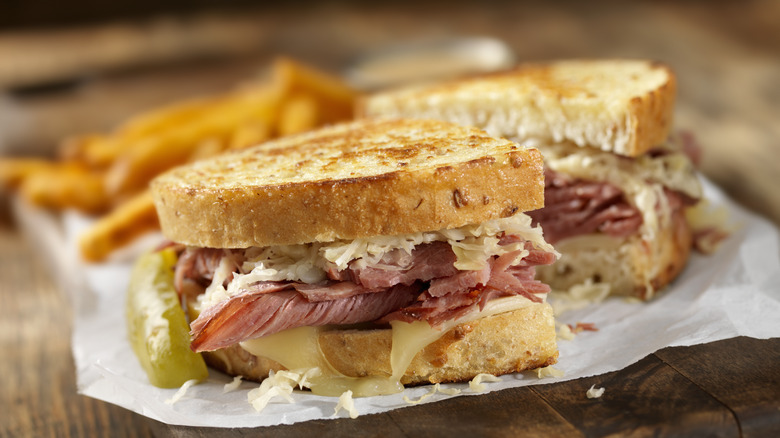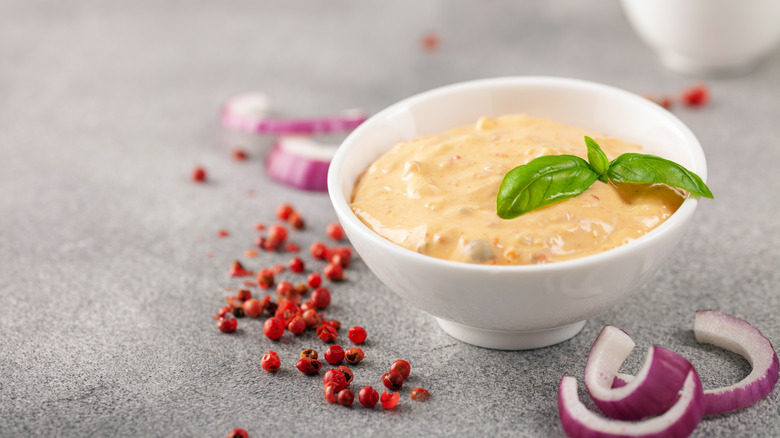Why Fast Food Special Sauce Is Always The Same Thing
Frankly, the term "special sauce" is a bit of a misnomer. Many burger joints and fast food places, from Shake Shack to McDonald's and In-N-Out Burger, have a house sauce. However, this special sauce is almost always some variation on the same thing: a pink, creamy sauce that is, in essence, a spin on Thousand Island dressing.
Why is that? The answer is a bit murky (and pink), but it essentially comes down to convenience. Special sauces — and, for that matter, Thousand Island dressing — consist of ingredients readily available in most restaurant kitchens. After all, a basic Thousand Island dressing usually consists of mayonnaise, mustard, vinegar, ketchup, and relish. However, many variations on this dressing allow for infinite adjustability and tweaking.
For example, McDonald's special sauce, or Big Mac sauce, doesn't include tomato and instead uses mustard. Meanwhile, In-N-Out's sauce doesn't use mustard and instead adds ketchup, vinegar, and sugar. Regardless, each of these sauces gives burgers a tangy, creamy kick — and diners can't seem to get enough.
The versatility of Thousand Island dressing
The magic of special sauce, or Thousand Island dressing, extends far beyond hamburgers. Perhaps the most famous usage of Thousand Island dressing is in the meaty Reuben sandwich, contending with the intense flavors of sauerkraut and corned beef — but that's not the end of this dressing's capabilities. Thousand Island is somewhat of a chameleon in the kitchen and is more prevalent than many diners might think. This might be because, as previously mentioned, the sauce is whipped up from ingredients readily on hand in restaurant kitchens. Combining these simple ingredients creates a flavor profile that works far beyond its use on your favorite fast food hamburger.
The tangy, creamy, and unique flavor profile of Thousand Island works with many different flavor profiles. From cheeseburgers to sandwiches, fries, and even seafood salads, it highlights the unique aspects of whatever you combine with it. For example, a dollop of Thousand Island might make the perfect addition to your next batch of deviled eggs. You might also try switching your ranch dip out for Thousand Island as a dipping sauce for your veggie platter — but don't immediately go for the bottled stuff. After all, you can whip up a homemade Thousand Island dressing with ingredients you probably already have.
The origins of Thousand Island dressing
Given this sauce's inclusion in many dishes, you may wonder where Thousand Island dressing comes from. After all, the creamy salad dressing is a staple at most restaurants, where it's used to top sandwiches along with salads, fries, and onion rings. The history behind this not-so-secret sauce seems to be murky at best: There are two competing narratives behind its origins.
The first theory names Waldorf-Astoria proprietor George Boldt as the inventor. The story goes that Boldt had neglected to pack dressing for his salad while on vacation on his yacht. Bereft of any ready-made dressing, Boldt whipped up a sauce from what he already had available. The other origin story for Thousand Island names Sophia LaLonde as the inventor. In the early 20th century, Sophia and her husband owned The Thousand Islands Inn in Clayton, New York, where they reportedly served the sauce to customers. Either way, the sauce has impacted the landscape of American food culture.
The somewhat muddled origins of the sauce also point to its universality. The combination of ketchup and mayonnaise, which serves as the basis for Thousand Island dressing, is pretty ubiquitous. This combination of ingredients can be found throughout many cultures, from Idaho's fry sauce to Germany's Rot Weiss, an unmixed striped sauce of mayonnaise and ketchup that is often served from a tube. Wherever you turn, it seems like there is no stopping diners from finding their way to this tangy and very "special" sauce.


